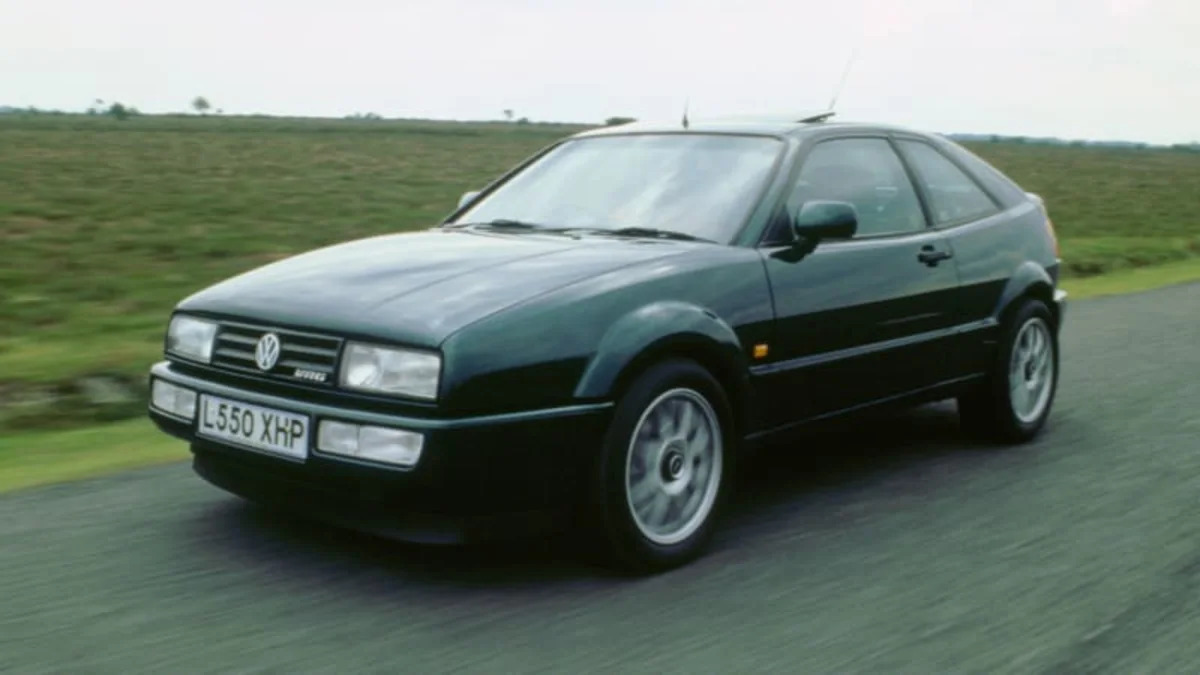Will you have the 1.8-liter four? Can we interest you in the supercharged G60, or perhaps a 190-horsepower VR6?
Count the fingers on one hand, and you still won’t reach the total number of engine variants that Volkswagen, through about seven years into the Nineties, plopped under the hood of the now-it’s-here, now-it’s-gone Corrado coupe. We didn't get all those engines or even all of those model years in the States, but it's an impressive collection all the same.
Despite its seductive, fastback shape, exceptional (for a VW) handling dynamics, and (mostly) overachieving power, some aficionados of the brand found the Corrado’s bite a bit too harsh, even though its platform was based on that of the more sedate Mark 2 Golf. But never was it cursed with the “hairdresser’s car” label, and the few who bought one in this country agreed with one critic’s assessment, that it is “the textbook definition of a cult car classic.”



Why is the Volkswagen Corrado a future classic?
As the sporty segue to the angular Scirocco, the front-wheel, 2-plus-2 Corrado, launched at the end of 1988 near the Scirocco’s final bow, was an obvious attempt by the Germans to go upmarket. Although still compact at just under 160 inches long, this car rode on a longer, wider wheelbase than the Golf, and was 300-plus pounds heavier.
With its extended hood/abbreviated deck, it had the credentials that allowed it to take a swipe at Audi: cushy velour or leather seats, a spoiler that automatically rose at speeds over 45 MPH, and a body assembled by the now-defunct Karmann coachworks, so that its hardware integrity was above average.
Worldwide, less than 100,000 cars were built overall, and only a fifth of that number were sold in the U.S., where the Corrado met with some headwinds regarding price and reliability. And while the SUV was just a shadow in the Corrado’s rear view mirror in the Nineties, it was gaining.
Still, some educated drivers saw its possibilities, especially with the VR6 engine and the stick shifter that appeared in 1992. The VR6, which stood for the German "Vee Reihenmotor" or "V-inline,” was a stout 2.8-liter, 6-cylinder, high-compression beauty that made 178 horsepower in the States and accelerated aggressively with 177-lbs ft of torque at 4,200 rpm.
It followed the supercharged G60 which, at 1.8 liters, made 158 horsepower at 5,600 rpm, 166-lbs ft of torque at 4,000 rpm and a sexy supercharger whine. The G60 was deemed adequate but nothing more; some tests rated its 0-60 time at eight seconds. It was soon eclipsed by the VR6, when Autocar pronounced the Corrado "one of the best front-wheel-drive cars of all time” and Britain’s CAR magazine named it as one of the "25 cars you must drive before you die."
But is it a genuine collectable? “A pretty good one,” says Mark Gillies, now a spokesman for Volkswagen of America. “There are fewer and fewer good ones…they were pretty and fast, and values are starting to edge up. Not quite in the way the Golf R32 has been edging up, but it's in that late 1980s/early 1990s space where people who lusted after them as kids now have the wherewithal to buy them.”
The Corrado actually arrived in the U.S. in 1990 with an MSRP close to $18,000. The price jumped to $25,150 during its final year in the States, 1994. By then the car was designated SLC, for sport luxury coupe.

Volkswagen never hinted at a Corrado redux, although it did revive the Scirocco name in 2008, slotting it as a kind of hot hatch plus, once again based on the Golf (the MK5 edition this time around), but much prettier. Two turbocharged gas engines were offered, as well as a diesel and a seven-speed DSG automatic. This ultimate Scirocco lasted only until 2017; it was never sold in the United States because VW feared it would cannibalize sales of the GTI.
Some may argue that the Corrado would’ve made a nifty convertible — and, therefore, a more likely “collectible.” But at the outset, VW design chief Herbert Schäfer opted for practicality over sex appeal and a boy-racer image. There’s no denying the Corrado had a unique personality, and that in itself is one reason to covert this small hatchback.
What is the ideal example of a VW Corrado?
First, you'll need to decide between the aforementioned supercharged four-cylinder G60, available from 1990 through the early part of 1992, or the torque-rich six-cylinder VR6 that bowed in 1992. Then, pick between a desirable manual transmission or the optional automatic. Over the course of its five years on the market in the States, around 17,000 were sold in total, which means you might have to cast a wide net to find the right model for you.
Our used vehicle listings can be helpful to find a good deal near you. Narrow the offerings down by a radius around your ZIP code, and pay attention to the deal rating on each listing to see how a vehicle compares with others in a similar area.
Bring a Trailer recently showed more than 50 Corrados with varying specs that were sold for $12,000 to $20,000, with some low mileage examples priced at up to $30,000.
Are there any good alternatives to the VW Corrado?
There's a robust selection to consider from the Nineties. Certainly the Mazda Miata fits into the sporty compact category, as well as the aforementioned Scirocco and the GTI. For those intending to move up, there’s the BMW 3 Series.
Related video:


Sign in to post
Please sign in to leave a comment.
Continue